
-
Table of Contents
Unlock the secrets to recording and editing a high-quality video podcast today! Learn the essential tips and techniques to captivate your audience and produce professional-grade content. Don’t wait—start your journey to podcasting success now! Click here to get started!
Introduction
Creating a high-quality video podcast involves several key steps, from planning and recording to editing and publishing. To start, you’ll need to choose the right equipment, including a good camera, microphone, and lighting setup, to ensure clear audio and sharp visuals. Planning your content is crucial; outline your episodes, prepare scripts or talking points, and decide on the format and style of your podcast. During recording, pay attention to framing, background, and sound quality. Once recorded, use video editing software to cut out mistakes, add transitions, and enhance audio and video quality. Finally, export your video in a suitable format and upload it to your chosen platform, optimizing it for search and audience engagement. By following these steps, you can produce a professional and engaging video podcast that resonates with your audience.
How to Record and Edit a High-Quality Video Podcast: Essential Tips and Equipment for Video Podcasting Success
Creating a high-quality video podcast involves a blend of technical know-how, the right equipment, and a keen eye for detail. To begin with, selecting the appropriate recording equipment is paramount. A high-definition camera is essential for capturing clear and crisp visuals. While many podcasters start with webcams or smartphone cameras, investing in a DSLR or mirrorless camera can significantly enhance the video quality. Additionally, a tripod or stabilizer ensures steady shots, eliminating the distracting shakes that can detract from the viewer’s experience.
Equally important is the audio quality. Clear, professional-sounding audio can make or break a video podcast. A high-quality microphone, such as a condenser or dynamic microphone, is crucial. USB microphones are user-friendly and suitable for beginners, while XLR microphones offer superior sound quality for more advanced users. To further enhance audio clarity, consider using a pop filter to minimize plosive sounds and a shock mount to reduce vibrations.
Lighting is another critical component. Proper lighting can dramatically improve the visual appeal of your video podcast. Natural light is an excellent option if you have access to it, but it can be inconsistent. Therefore, investing in artificial lighting, such as softbox lights or ring lights, can provide consistent and flattering illumination. Positioning the lights at a 45-degree angle from your face can help eliminate harsh shadows and create a balanced look.
Once the recording setup is in place, the next step is to focus on the recording environment. A quiet, controlled space is ideal for minimizing background noise and distractions. Acoustic treatments, such as foam panels or blankets, can help reduce echo and improve sound quality. Additionally, a visually appealing background can enhance the overall aesthetic of your video podcast. Whether it’s a bookshelf, a branded backdrop, or a simple, clean wall, the background should complement the content without being distracting.
With the recording environment optimized, it’s time to move on to the actual recording process. Before hitting the record button, it’s beneficial to create a detailed outline or script. This ensures that the content flows logically and covers all the key points. During the recording, maintaining good posture and making eye contact with the camera can help create a more engaging and professional presentation. It’s also important to speak clearly and at a moderate pace, allowing viewers to easily follow along.
After recording, the editing phase begins. Editing is where you can polish your video podcast, adding elements that enhance the viewer’s experience. Video editing software, such as Adobe Premiere Pro, Final Cut Pro, or even free options like DaVinci Resolve, offers a range of tools for cutting, trimming, and arranging clips. Adding transitions, text overlays, and graphics can make the video more dynamic and visually appealing. Additionally, color correction and grading can help achieve a consistent and professional look.
Audio editing is equally crucial. Software like Audacity or Adobe Audition allows you to clean up the audio, removing background noise and adjusting levels for consistency. Adding background music or sound effects can also enhance the overall production value. Synchronizing the audio with the video is essential to ensure that the final product is cohesive and professional.
In conclusion, recording and editing a high-quality video podcast requires careful planning, the right equipment, and attention to detail. By investing in good recording gear, optimizing your recording environment, and utilizing powerful editing software, you can create a video podcast that stands out and engages your audience effectively.
Q&A
1. **How can I record and edit a high-quality video podcast?**
– **Recording:**
1. **Equipment:** Use a high-quality camera (DSLR, mirrorless, or a high-end webcam) and a good microphone (condenser or dynamic mic).
2. **Lighting:** Ensure proper lighting with softbox lights or ring lights to avoid shadows and enhance video quality.
3. **Environment:** Choose a quiet, well-decorated space with minimal background noise and distractions.
4. **Software:** Use recording software like OBS Studio or dedicated podcast recording tools.
5. **Framing:** Position the camera at eye level and ensure the subject is well-framed.
– **Editing:**
1. **Software:** Use video editing software like Adobe Premiere Pro, Final Cut Pro, or DaVinci Resolve.
2. **Audio Sync:** Ensure audio and video are properly synced.
3. **Cuts and Transitions:** Make clean cuts and use smooth transitions to maintain flow.
4. **Color Correction:** Adjust color balance, brightness, and contrast for a polished look.
5. **Audio Editing:** Use tools to remove background noise, equalize sound levels, and add effects if necessary.
6. **Graphics and Titles:** Add intro/outro sequences, lower thirds, and any relevant graphics or text.
7. **Export Settings:** Export the video in high resolution (1080p or 4K) with appropriate bitrate settings for the platform you’re using.